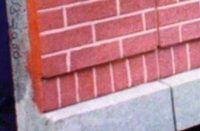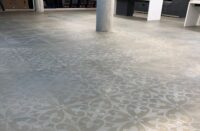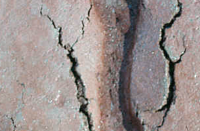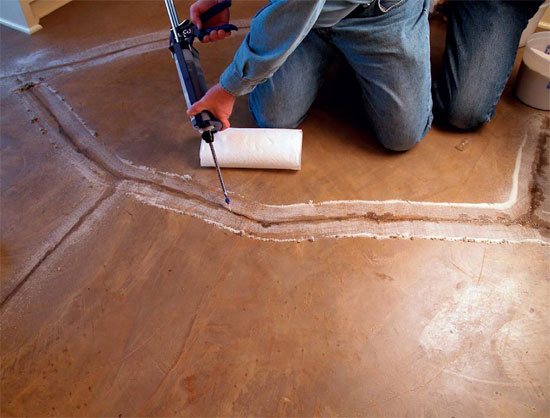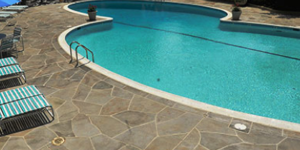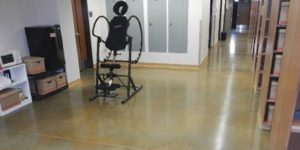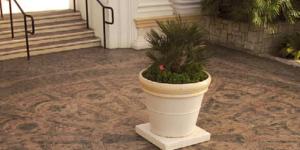Colors must be matched. Costs must be controlled. There are all sorts of variables to consider when repairing a decorative concrete floor. Luckily, several products aim to help you get things fixed.
From sprays to penetrating patches to tinted polyurethane cement, engineers continue developing new ways to match colors and speed up repairs of decorative concrete.
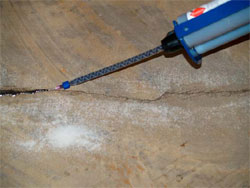
There is a wide range of patch and repair products available, from AB epoxies to polymer modified cements. And while technology has done well to address the problems of strength and durability, color matching with polymer stains and dyes remains an imperfect science.
“Color is essential to decorative concrete projects and all repairs rely on a matching or blending color,” says Brandon Carpenter, marketing manager for Floric Polytech. “In decorative applications, any patch or repair usually looks like patches or repairs. It is truly an art to be able to masterfully blend in repairs so as not to be noticed.”
That art, he says, is at a skill level beyond the ability to apply decorative concrete. Other suppliers agree.
“Don’t expect an absolutely perfect match, because it just won’t happen. You’ll drive yourself crazy,” says Chris Sullivan, national sales manager for QC Construction Products.
So it is important to make customers aware of the limitations of color matching. That said, there is a wide range of products designed to enable you to get very close.
When decorative concrete contractors think about patches, they are not usually looking for the typical aspects of a concrete or overlay product, Carpenter says.
“The number-one quality desired in patch material is fast drying,” he says. “Dry times are essential, especially in commercial settings. Oftentimes you only have from closing one night to opening the next day to have the repair started and finished.”
The products cover a wide spectrum of materials. For example, there is a host of repair mortars available, says Carpenter, typically based on acrylic, latex or styrene-butadiene rubber (SBR) polymer modified cements. Polymers give repair mortars superior compression strength, flexibility, reduced shrinkage and faster dry times.
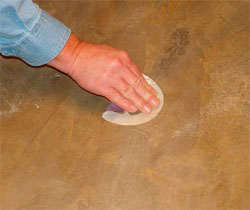
Kelton Glewwe, vice president of marketing at Roadware Inc., says that applicators also look for a patch product that won’t lead to callbacks.
“Contractors are looking for performance and cost effectiveness over the whole job. They want to make a repair one time with a product they are confident will work,” he says. “There are many products on the market that fail more often then they work. Contractors are looking for a product that saves them time and makes the end product work better and look better.”
Sullivan sees the same trend in his QC Construction Products customers. Specifically, they want a product that becomes part of the substrate, and therefore lasts as long as the substrate. That is particularly important in an exterior application, such as stamped concrete with integral colors. This is where contractors want something that will last the life of the decorative work.
In an interior job that has been stained, color is often more important than strength. Experienced applicators select mixes that are receptive to stains or dye. For example, Sullivan says, cementitious products with high polymer content resist dye. These high-polymer products grind and polish well, but color must be applied to them as a coating or overlay. It should be noted that engineers at Roadware are working on tinting technology for their polyurethane Mender line.
Some penetrating materials do not require a bonding primer. However Carpenter at Floric Polytech says that with repair mortars, “often it is a good idea to use a bond coat, even with products that typically don’t require one.”
Here are some specific products available for patching.
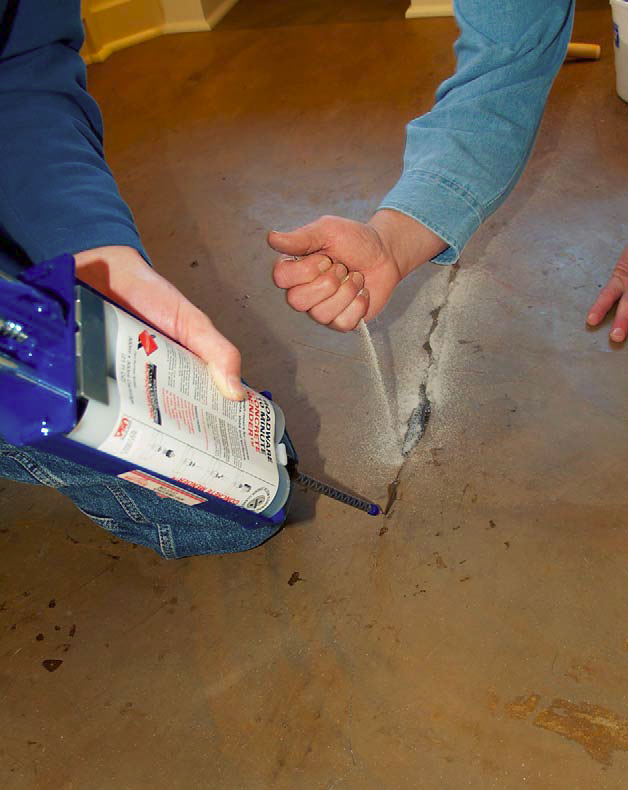
10 Minute Concrete Mender
This polyurethane product from Roadware Inc. specializes in fast drying and penetration. Concrete Mender penetrates concrete surfaces and eliminates bond lines that can fail, says Glewwe. The repair becomes part of the concrete, will not turn brittle like an epoxy, and is more reliable than polyurea.
The key technological characteristic to Concrete Mender’s performance is the viscosity. It has a viscosity of less than 8 cps with a surface tension one third that of water. That means that when applied, water beads on the surface, and the product penetrates the substrate. Roadware calls this trademarked process Microdoweling.
Concrete Mender mixes with manufactured sand, which enables it to move with the concrete and accept most coatings. It polishes without melting or clogging diamond pads and blends into the surrounding finish.
Concrete Mender’s advantage over many similar products is its speed. “Concrete Mender can save a contractor a whole day because repair work and decorative treatments can be done on the same shift,” Glewwe says. “No more making repairs and coming back the next day to find someone turned on the sprinkler overnight or the local kids messed up all your prep work.”
This product does not need a bonding primer. However, it is not the final step. While it can be polished, it cannot take acid stain or dyes. For color, it must be coated after application. Meanwhile, the company’s lab is working on a formula that can be tinted to match the color of the substrate.
MT-200 Spray-Topping
Floric Polytech recently introduced MT-200 Spray-Topping. An ultra-thin version of Floric’s MT-200, it can be applied to stamped concrete by sprayer, providing a new surface while retaining the texture of the previous stamped surface.
Using integral colors in MT-200 Spray-Topping can eliminate color-matching issues when it is used to coat the entire application. MT-200 can also be applied by sprayer or trowel to fill in spots. It is fast-drying, despite a high cement content that makes it harder than typical microtoppings.
Crack Repair Kit
QC Construction Products’ Crack Repair Kit is an AB epoxy and repair fabric designed to bridge most nonmoving cracks. It is for use in conjunction with overlayments, such as QC’s Thin-Pave NI and Concrete Resurfacer.
The downside of epoxies such as this QC product is they can turn brittle with age compared to polymer cements and are usually not a good choice for exterior work. The upside of QC’s system is color-matching. QC offers the same 42-color palette for all of its overlayments. This helps keep color selection consistent across all applications.
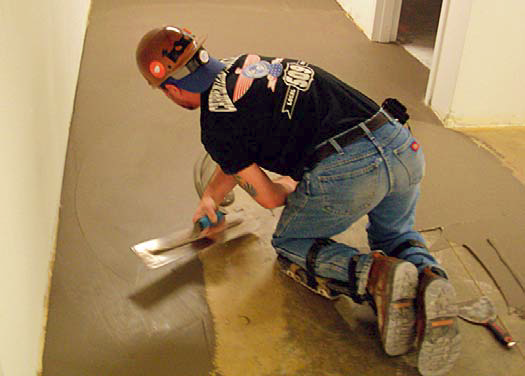
SkimCrete XL
SkimCrete XL is a fast-drying version of Dependable Floor Products’ SkimCoat, which has been on the market for more than four decades. A latex-modified cement patch and underlayment, it is designed for a wide range of surfaces — concrete, wood, or adhesive residue — as long as they are interior. The product is most often used to rehab subfloors, as it is formulated to meet the requirements of adhesive manufacturers.
Meadow-Patch T1
This is a one-component, polymer-modified, cementitious repair mortar. Produced by W.R. Meadows, it is designed for maintenance patching and minor repairs.
Thicker than liquid-polymer and epoxy products, it can be used for overhead or vertical applications, and it is suitable for rubber-wheel traffic on floors. Because of its bond and freeze-thaw resistance, Meadow-Patch T1 may be used for interior and exterior applications, above or below grade.
Typical of a mortar, what Meadow-Patch T1 provides in versatility, it loses in speed. It takes two hours to set and one day to cure.
CrownWear
Crown Polymers LLC produces its CrownWear line for cold-weather applications and tough environments. The medium-modulus epoxy polymer concrete comes in three different mixes, one that cures in temperatures down to 40 degrees, one that cures as low as 20 degrees, and another that cures underwater. The low-modulus mix cures down to 32 degrees. CrownWear is used for shallow, partial and full-depth patching, wide-void grouting, kerf filling, and vehicular and industrial traffic concrete-surface overlayment.
